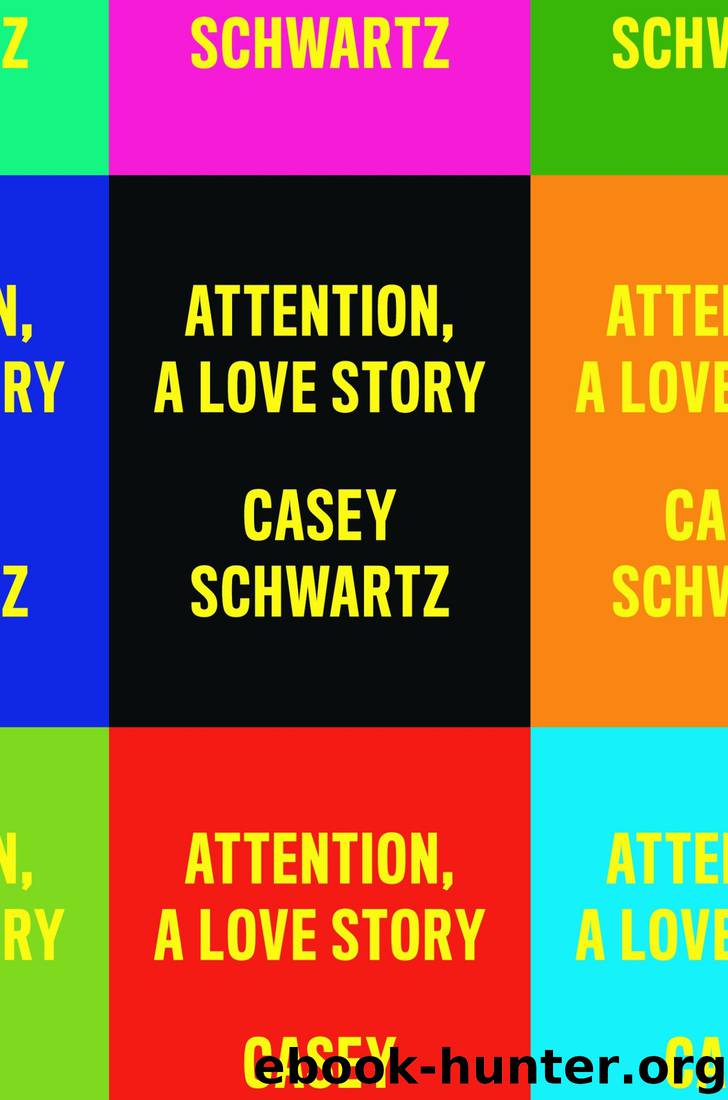Attention: A Love Story by Casey Schwartz

Author:Casey Schwartz
Language: eng
Format: epub
Publisher: Pantheon
Published: 2020-04-06T23:00:00+00:00
8
I was back in San Francisco within the year. I’d returned in pursuit of a subject about which I had far more ambivalence than psychedelic science. I was making the trip that someone inevitably makes if they’re trying to understand the current landscape of attention: I’d come to try to glimpse Silicon Valley for myself, the very infrastructure of our attention economy. But I landed at SFO with some sense of futility. I was here to try to gain some insight of my own into a land so mythologized and satirized, I wasn’t even sure where, strictly speaking, it was located.
The attention economy itself, of course, is nothing new. We’ve long since existed within it. Tim Wu, the Columbia University law professor and writer, describes its evolution in his book The Attention Merchants. Wu points to an example we’d now consider charming or even quaint: the posters designed in the nineteenth century by the French artist Jules Chéret. All over Paris, these posters went up, displaying images of comely women showing lots of leg, advertising for wine, for the opera, for the music hall. In Paris, advertisements themselves were nothing new, but Chéret’s vivid style—and all that naked female skin—was a radical innovation.
At first, Chéret was much admired for his posters, even awarded the Legion of Honor. But soon, his work had spawned imitators, unleashing a “poster craze” on Europe and America. Paris, the epicenter, became “hardly more than an immense wall of posters scattered from the chimneys down to sidewalks with clusters of squares of paper of all colors and formats…” goes one contemporary account.
It didn’t take long for Parisians to demand the return of their beautiful city, with their sight lines uncluttered, their minds unmolested by more and more flyers urging them to spend money whenever they turned their heads. The municipal authorities took action, restricting the posters’ placement throughout the city. Those restrictions remain in place today.
Across the Atlantic, at least a few Americans felt a similarly allergic reaction when, in 1948, the city of Washington, DC, struck a deal with Muzak. Background music and commercials began pumping into the city’s trolleys and buses. Most DC commuters did not seem to mind the new noise level, but two lawyers felt differently. Franklin Pollak and Guy Martin sued the city, deeply offended by Muzak’s invasion of public air space. Pollak and Martin were arguing against what they said amounted to no less than “an unlawful deprivation of liberty under the Constitution,” writes Louis Menand in his description of the episode. By 1952, their case made its way to the Supreme Court. They lost, but exactly one justice agreed with them. William O. Douglas believed that this case was, at its core, about privacy, or “the right to be let alone,” as he put it.
“The right of privacy,” Douglas wrote in his dissent, “is a powerful deterrent to any one who would control men’s minds.” Douglas’s opinion was duly recorded. And the Muzak played on.
We know from
Download
This site does not store any files on its server. We only index and link to content provided by other sites. Please contact the content providers to delete copyright contents if any and email us, we'll remove relevant links or contents immediately.
The Art of Thinking Clearly by Rolf Dobelli(8841)
Mindhunter: Inside the FBI's Elite Serial Crime Unit by John E. Douglas & Mark Olshaker(7833)
Change Your Questions, Change Your Life by Marilee Adams(6641)
Nudge - Improving Decisions about Health, Wealth, and Happiness by Thaler Sunstein(6633)
Mastermind: How to Think Like Sherlock Holmes by Maria Konnikova(6235)
The Power of Now: A Guide to Spiritual Enlightenment by Eckhart Tolle(4754)
Men In Love by Nancy Friday(4320)
Factfulness: Ten Reasons We're Wrong About the World – and Why Things Are Better Than You Think by Hans Rosling(4021)
The Confidence Code by Katty Kay(3566)
Thinking in Bets by Annie Duke(3531)
Man and His Symbols by Carl Gustav Jung(3315)
Three Women by Lisa Taddeo(2920)
The Worm at the Core by Sheldon Solomon(2917)
Why Buddhism is True by Robert Wright(2826)
Liar's Poker by Michael Lewis(2810)
The Inner Life of Animals by Peter Wohlleben(2765)
Descartes' Error by Antonio Damasio(2731)
The Power of Mindful Learning by Ellen J. Langer(2710)
The Slow Fix: Solve Problems, Work Smarter, and Live Better In a World Addicted to Speed by Carl Honore(2574)
